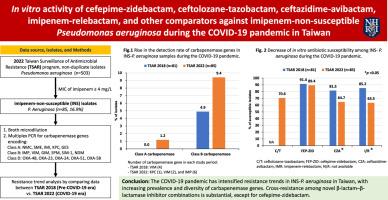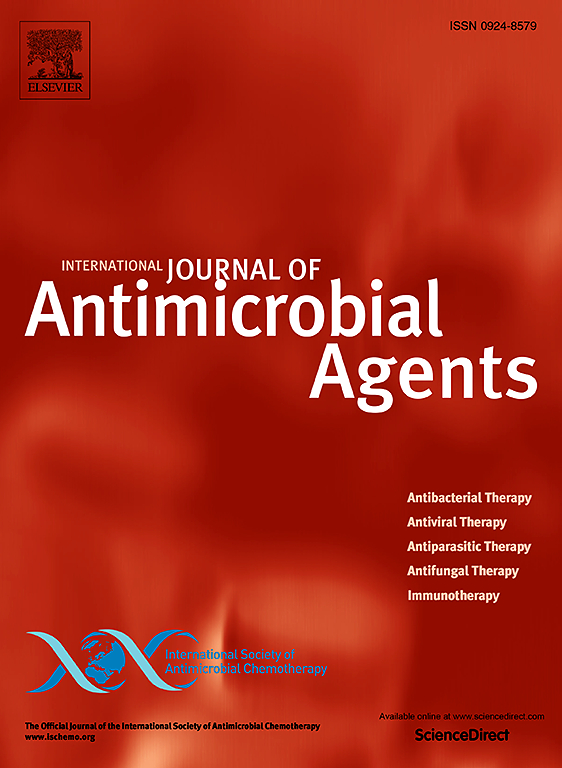In vitro activity of cefepime-zidebactam, ceftolozane-tazobactam, ceftazidime-avibactam, imipenem-relebactam, and other comparators against imipenem-non-susceptible Pseudomonas aeruginosa in Taiwan, 2022
IF 4.6
2区 医学
Q1 INFECTIOUS DISEASES
International Journal of Antimicrobial Agents
Pub Date : 2025-06-04
DOI:10.1016/j.ijantimicag.2025.107550
引用次数: 0
Abstract
Objectives
The global expansion of antimicrobial-resistant Pseudomonas aeruginosa, particularly imipenem-non-susceptible (INS) strains poses a formidable health threat. The COVID-19 pandemic has exacerbated antimicrobial resistance trends. We compared the pre- and post-pandemic antibiotic resistance patterns of INS-P. aeruginosa in Taiwan.
Methods
We analysed 503 P. aeruginosa isolates collected through the Taiwan Surveillance of Antimicrobial Resistance (TSAR) program during 2022. Minimum inhibitory concentrations of various antibiotics were determined by using broth microdilution. Carbapenemase-encoding genes were identified via multiplex PCR. Antimicrobial resistance trends were compared with data from 2018.
Results
INS-P. aeruginosa comprised 16.9% (85/503) of isolates and exhibited high-level multi-drug resistance. Novel β-lactam–β-lactamase inhibitor combinations (BL-BLIs) demonstrated the highest activity, with 89.4% of INS isolates remaining susceptible to cefepime-zidebactam. However, the susceptibility rates of INS-P. aeruginosa isolates to other BL-BLIs and comparators declined between 2018 and 2022. Specifically, susceptibility to ceftazidime-avibactam and imipenem-relebactam declined significantly from 81.5% and 85.2% in 2018 to 64.7% and 63.5% in 2022, respectively (both P < 0.05). Additionally, only 70.6% of isolates obtained during 2022 were susceptible to ceftolozane-tazobactam. Carbapenemase genes were detected in 10.6% of isolates, with a notable increase in blaKPC and blaIMP prevalence compared to pre-pandemic data.
Conclusion
The COVID-19 pandemic intensified resistance trends in INS-P. aeruginosa in Taiwan, with increasing prevalence and diversity of carbapenemase-encoding genes. Continuous monitoring and expanded research are essential to combat evolving resistance patterns.

头孢吡肟-齐德巴坦、头孢洛嗪-他唑巴坦、头孢他啶-阿维巴坦、亚胺培南-雷巴坦等比较物对亚胺培南不敏感铜绿假单胞菌的体外活性研究,台湾,2022。
目的:抗微生物铜绿假单胞菌的全球扩张,特别是亚胺培南不敏感(INS)菌株构成了巨大的健康威胁。COVID-19大流行加剧了抗菌素耐药性趋势。我们比较了INS-P在大流行前和大流行后的抗生素耐药性模式。台湾的绿脓杆菌。方法:对台湾省2022年抗菌药物耐药性监测(TSAR)项目收集的503株铜绿假单胞菌进行分析。采用肉汤微量稀释法测定各种抗生素的最低抑菌浓度。通过多重PCR鉴定碳青霉烯酶编码基因。比较了2018年的抗微生物药物耐药性趋势。结果:INS-P。铜绿假单胞菌占16.9%(85/503),表现出高水平的多药耐药。新型β-内酰胺-β-内酰胺酶抑制剂组合(BL-BLIs)活性最高,89.4%的INS菌株对头孢吡肟-齐德巴坦敏感。INS-P的易感性。从2018年到2022年,其他bl - bli和比较国的铜绿假单胞菌分离株数量下降。具体而言,对头孢他啶-阿维巴坦和亚胺培南-勒巴坦的易感性分别从2018年的81.5%和85.2%下降到2022年的64.7%和63.5% (pKPC和blaIMP患病率与大流行前的数据相比)。结论:COVID-19大流行加剧了INS-P的耐药趋势。随着碳青霉烯酶编码基因的流行和多样性的增加。持续监测和扩大研究对于对抗不断演变的耐药性模式至关重要。
本文章由计算机程序翻译,如有差异,请以英文原文为准。
求助全文
约1分钟内获得全文
求助全文
来源期刊
CiteScore
21.60
自引率
0.90%
发文量
176
审稿时长
36 days
期刊介绍:
The International Journal of Antimicrobial Agents is a peer-reviewed publication offering comprehensive and current reference information on the physical, pharmacological, in vitro, and clinical properties of individual antimicrobial agents, covering antiviral, antiparasitic, antibacterial, and antifungal agents. The journal not only communicates new trends and developments through authoritative review articles but also addresses the critical issue of antimicrobial resistance, both in hospital and community settings. Published content includes solicited reviews by leading experts and high-quality original research papers in the specified fields.

 求助内容:
求助内容: 应助结果提醒方式:
应助结果提醒方式:


